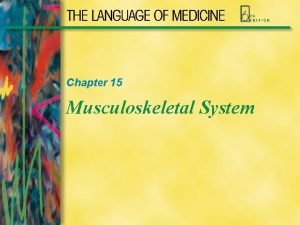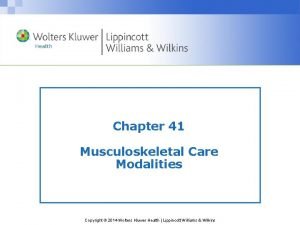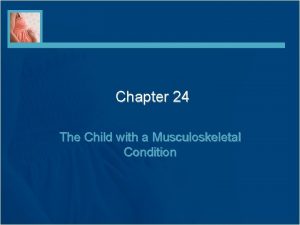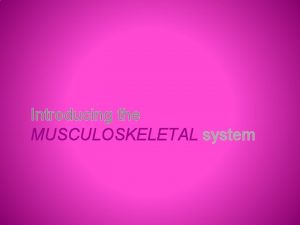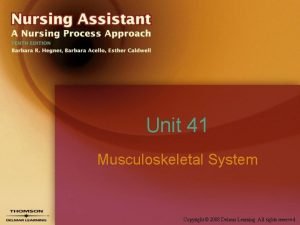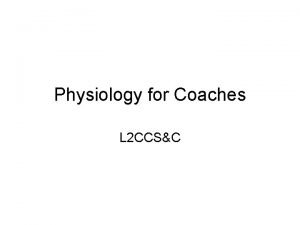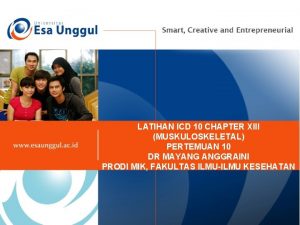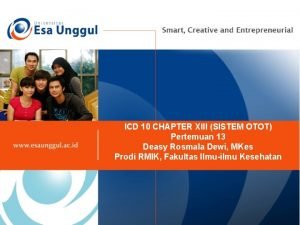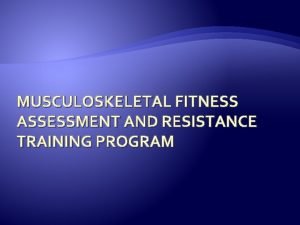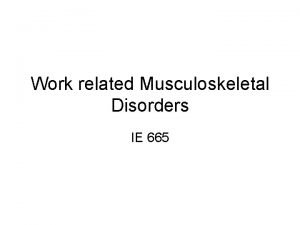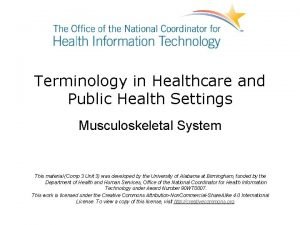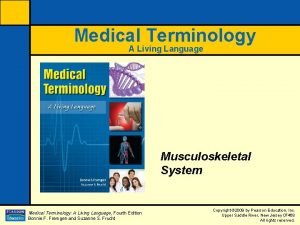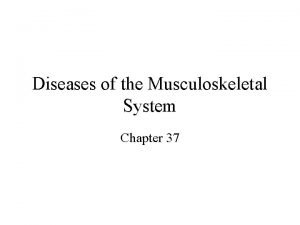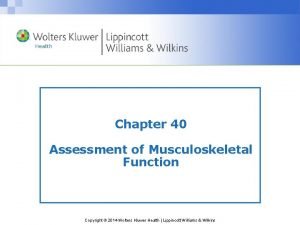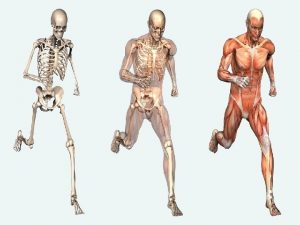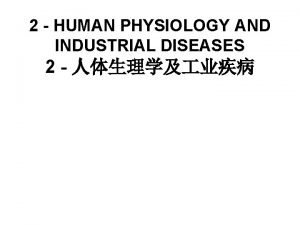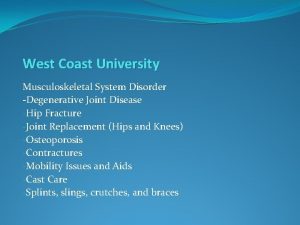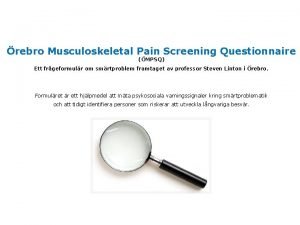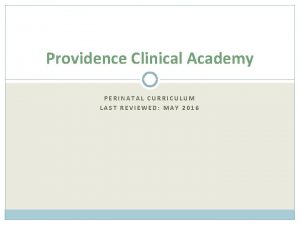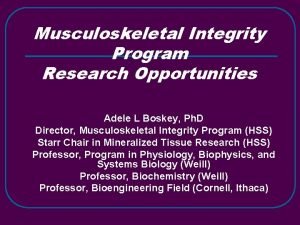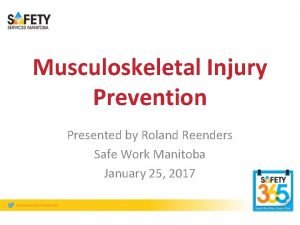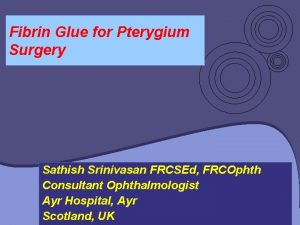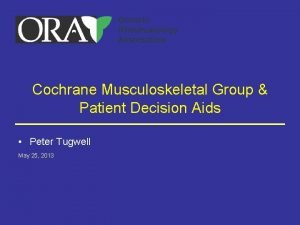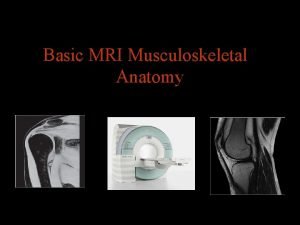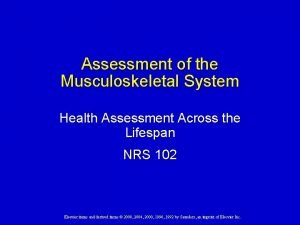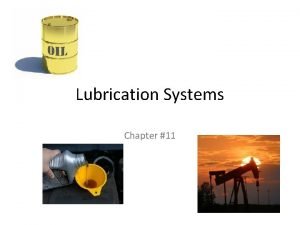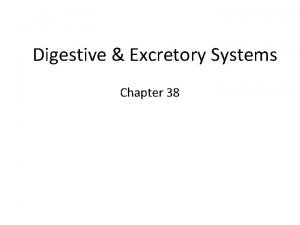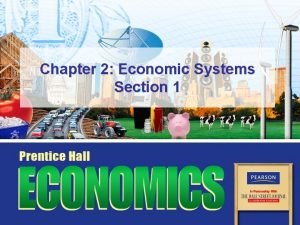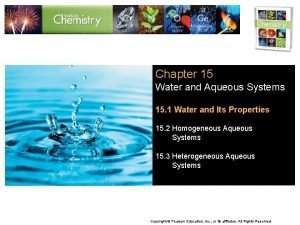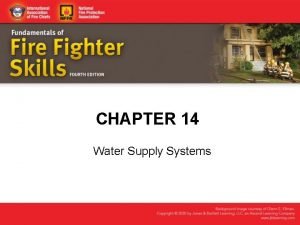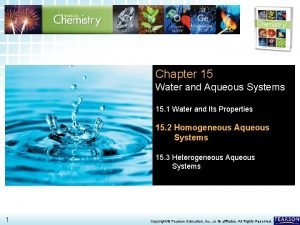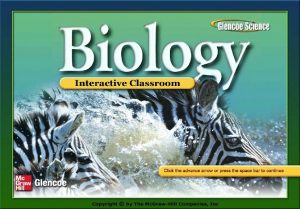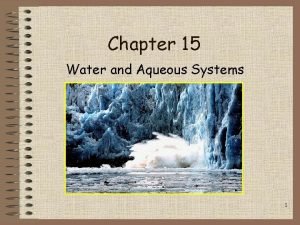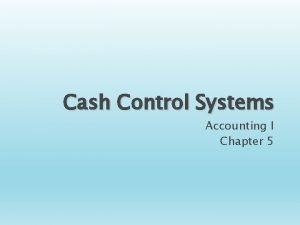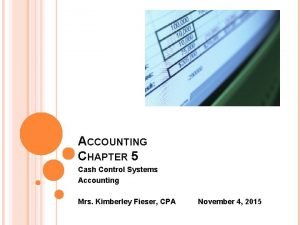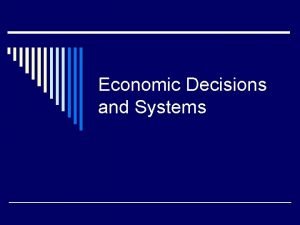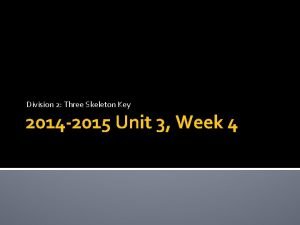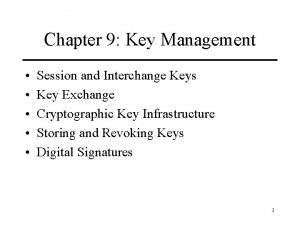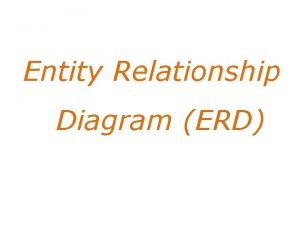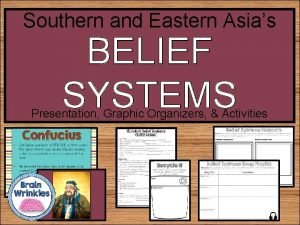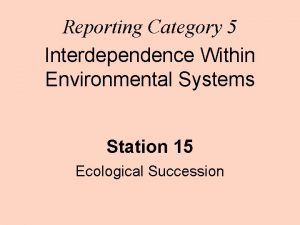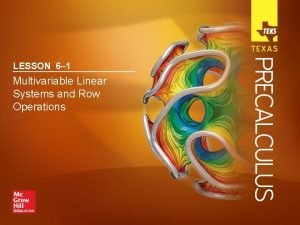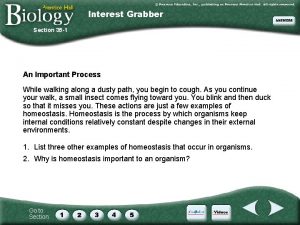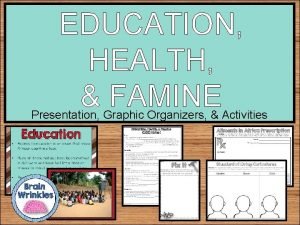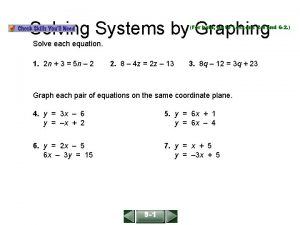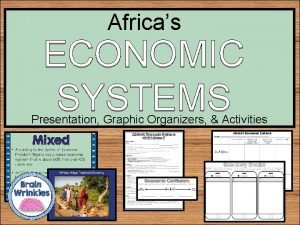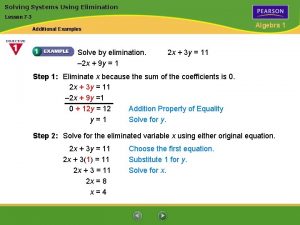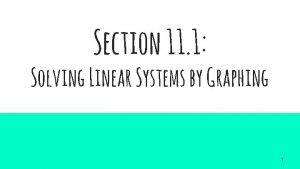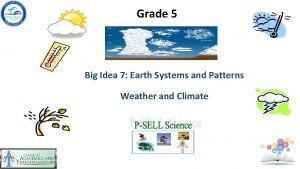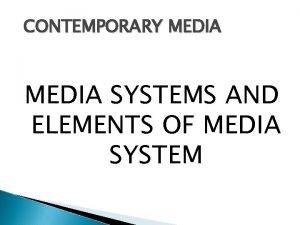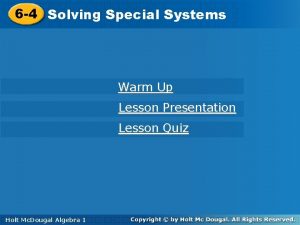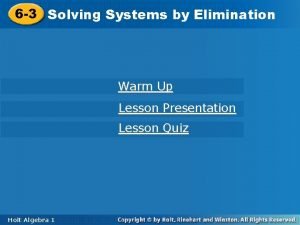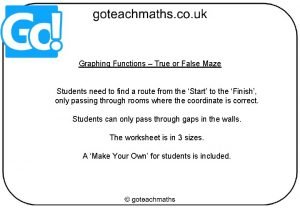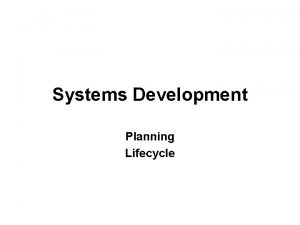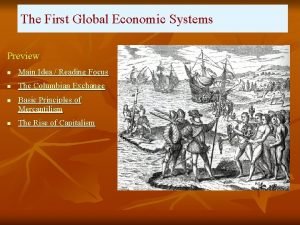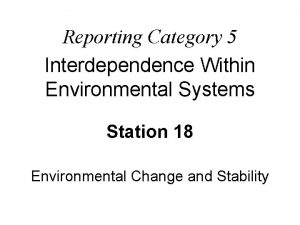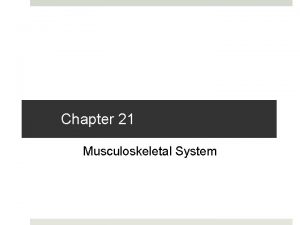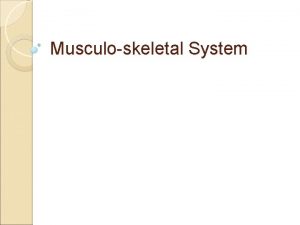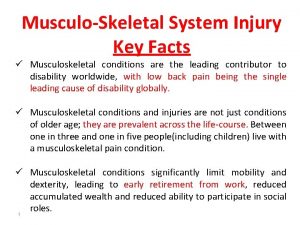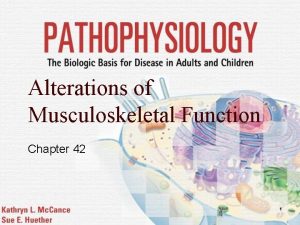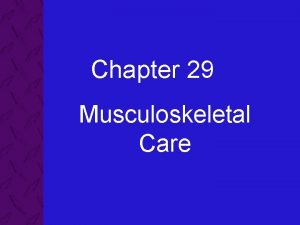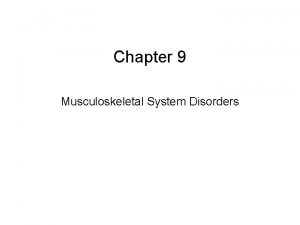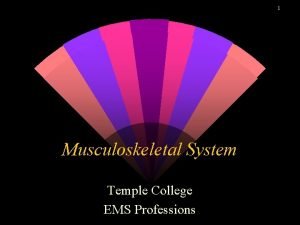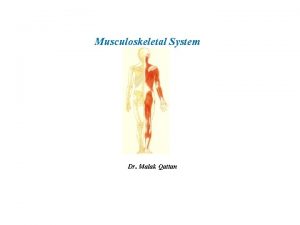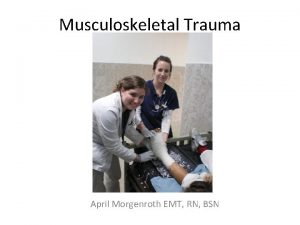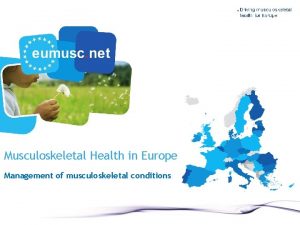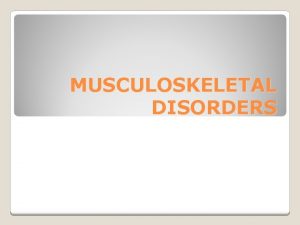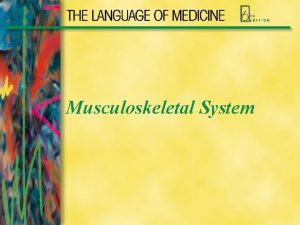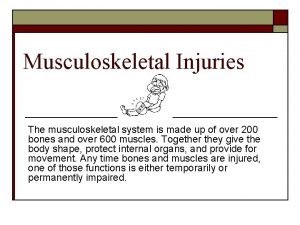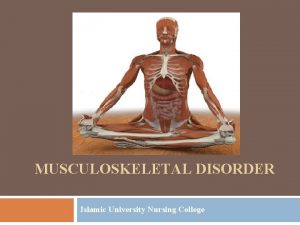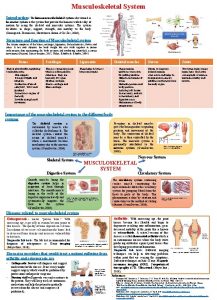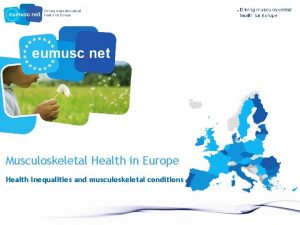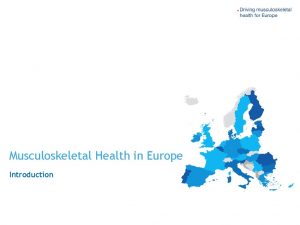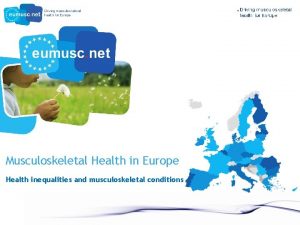36 Musculoskeletal Systems Chapter 36 Musculoskeletal Systems Key













































































- Slides: 77

36 Musculoskeletal Systems

Chapter 36 Musculoskeletal Systems Key Concepts • 36. 1 Cycles of Protein–Protein Interactions Cause Muscles to Contract • 36. 2 The Characteristics of Muscle Cells Determine Muscle Performance • 36. 3 Muscles Pull on Skeletal Elements to Generate Force and Cause Movement

Chapter 36 Opening Question How have musculoskeletal systems evolved to maximize force generation and do so at minimal metabolic cost?

Concept 36. 1 Cycles of Protein–Protein Interactions Cause Muscles to Contract Three types of vertebrate muscle: • Skeletal—voluntary movement, also breathing • Cardiac—beating of heart • Smooth—involuntary, movement of internal organs All use same sliding filament contractile mechanism.

Concept 36. 1 Cycles of Protein–Protein Interactions Cause Muscles to Contract Skeletal muscle (striated): Cells are called muscle fibers—are large and multinucleate Form from fusion of embryonic myoblasts One muscle consists of many muscle fibers bundled together by connective tissue.

Figure 36. 1 The Structure of Skeletal Muscle (Part 1)

Concept 36. 1 Cycles of Protein–Protein Interactions Cause Muscles to Contract Muscle contraction due to interaction of contractile proteins: • Actin—thin filaments • Myosin—thick filaments Each muscle fiber has several myofibrils— bundles of actin and myosin filament.

Concept 36. 1 Cycles of Protein–Protein Interactions Cause Muscles to Contract Each myofibril consists of sarcomeres— repeating units of overlapping actin and myosin filaments. Each sarcomere is bounded by Z lines, which anchor actin.

Concept 36. 1 Cycles of Protein–Protein Interactions Cause Muscles to Contract Other parts of sarcomere: A band in center—contains myosin H zone and I band—no overlap of actin and myosin M band within H zone—contains proteins

Figure 36. 1 The Structure of Skeletal Muscle (Part 2)

Figure 36. 1 The Structure of Skeletal Muscle (Part 3)

Concept 36. 1 Cycles of Protein–Protein Interactions Cause Muscles to Contract Titin—the largest protein in the body, runs the full length of the sarcomere. Bundles of myosin filaments are held in the center of the sarcomeres by titin. When muscle contracts, sarcomeres shorten and band pattern changes.

Figure 36. 2 Sliding Filaments

Concept 36. 1 Cycles of Protein–Protein Interactions Cause Muscles to Contract The sliding filament contractile model of muscle contraction depends on structure of actin and myosin: • Myosin molecule has two polypeptide chains coiled together, ending in a globular head • Myosin filament is many molecules in parallel • Actin filament is actin monomers in a long, twisted chain

Figure 36. 3 Actin and Myosin Filaments Overlap in Myofibrils

Concept 36. 1 Cycles of Protein–Protein Interactions Cause Muscles to Contract Muscle cells are excitable—membranes can conduct action potentials. Muscle contraction is initiated by action potentials from a motor neuron at the neuromuscular junction. A motor unit—all the muscle fibers activated by one motor neuron.

Concept 36. 1 Cycles of Protein–Protein Interactions Cause Muscles to Contract One muscle may have many motor units. To increase strength of muscle contraction —increase rate of firing of motor neuron or recruit more motor neurons to fire (more motor units activated).

Figure 36. 4 The Neuromuscular Junction

Concept 36. 1 Cycles of Protein–Protein Interactions Cause Muscles to Contract Action potentials in muscle fiber also travel deep within the cell. T tubules (transverse tubules) descend into the sarcoplasm (muscle fiber cytoplasm). T tubules run close to the sarcoplasmic reticulum—a closed compartment that surrounds every myofibril.

Figure 36. 5 T Tubules Spread Action Potentials into the Fiber

Concept 36. 1 Cycles of Protein–Protein Interactions Cause Muscles to Contract Two proteins span space between T tubules and sarcoplasmic reticulum and are physically connected. The dihydropyridine (DHP) receptor on the T tubule membrane is voltage-sensitive. The ryanodine receptor in the sarcoplasmic reticulum membrane is a Ca 2+ channel.

Concept 36. 1 Cycles of Protein–Protein Interactions Cause Muscles to Contract When an action potential reaches the DHP receptor it changes conformation. Ryanodine receptor then allows Ca 2+ to leave the sarcoplasmic reticulum. Ca 2+ ions diffuse into the sarcoplasm and trigger interaction of actin and myosin and sliding of filaments.

Concept 36. 1 Cycles of Protein–Protein Interactions Cause Muscles to Contract • Actin filament is actin monomers in a long, twisted molecule • Tropomyosin twists around actin; troponin attached at intervals • Myosin heads can bind specific sites on actin molecules to form cross bridges. Myosin changes conformation, causes actin filament to slide.

Figure 36. 6 Release of Ca 2+ from the Sarcoplasmic Reticulum Triggers Muscle Contraction

Concept 36. 1 Cycles of Protein–Protein Interactions Cause Muscles to Contract Cardiac muscle is also striated—cells are smaller than skeletal muscle and have one nucleus (uninucleate). Cardiac muscle cells also branch and interdigitate—can withstand high pressures. Intercalated discs provide mechanical adhesions between cells and contain gap junctions.

In-Text Art, Ch. 36, p. 718 (1)

Concept 36. 1 Cycles of Protein–Protein Interactions Cause Muscles to Contract Pacemaker and conducting cells initiate and coordinate heart contractions. Heartbeat is myogenic—generated by the heart muscle itself. Autonomic nervous system modifies the rate of pacemaker cells but is not necessary for their function.

Concept 36. 1 Cycles of Protein–Protein Interactions Cause Muscles to Contract Excitation and contraction of cardiac muscle differs from skeletal muscle: • T tubules are larger • DHP proteins in T tubules are Ca 2+ channels and are not connected to the ryanodine receptors Ryanodine receptors are ion-gated Ca 2+ channels, sensitive to Ca 2+.

Concept 36. 1 Cycles of Protein–Protein Interactions Cause Muscles to Contract In cardiac cells, action potential spreads through T tubules, opens voltage-gated Ca 2+ channels and Ca 2+ flows into sarcoplasm. • Increase in Ca 2+ opens the Ca 2+ channels in sarcoplasmic reticulum—large increase in Ca 2+ in sarcoplasm initiates fiber contraction Ca 2+-induced Ca 2+ release

Concept 36. 1 Cycles of Protein–Protein Interactions Cause Muscles to Contract Smooth muscle—in most internal organs, under autonomic nervous system control. Smooth muscle cells are arranged in sheets —have electrical contact via gap junctions. Action potential in one cell can spread to all others in the sheet.

Concept 36. 1 Cycles of Protein–Protein Interactions Cause Muscles to Contract Plasma membrane of smooth muscle cells is sensitive to stretch. Stretched cells depolarize and fire action potentials, which start contraction. Important for digestion.

In-Text Art, Ch. 36, p. 718 (2)

Concept 36. 1 Cycles of Protein–Protein Interactions Cause Muscles to Contract Neural influences on smooth muscle come from autonomic nervous system. Acetylcholine in digestive tract causes depolarization and action potentials, causing contraction. Norepinephrine causes the same cells to hyperpolarize, leading to fewer contractions.

Figure 36. 7 Neurotransmitters and Stretch Alter the Potential of Smooth Muscle Cells (Part 1)

Figure 36. 7 Neurotransmitters and Stretch Alter the Potential of Smooth Muscle Cells (Part 2)

Concept 36. 1 Cycles of Protein–Protein Interactions Cause Muscles to Contract Smooth muscle contraction: • Ca 2+ influx to sarcoplasm stimulated by stretching, action potentials, or hormones • Ca 2+ binds with calmodulin—activates myosin kinase, which phosphorylates myosin heads; can then bind and release actin

Figure 36. 8 The Role of Ca 2+ in Smooth Muscle Contraction

Concept 36. 2 The Characteristics of Muscle Cells Determine Muscle Performance In skeletal muscle—minimum unit of contraction is a twitch. Twitch measured in terms of tension, or force it generates. A single action potential generates a single twitch. Force generated depends on how many fibers are in the motor unit.

Figure 36. 9 Twitches and Tetanus

Concept 36. 2 The Characteristics of Muscle Cells Determine Muscle Performance Tension generated by entire muscle depends on: • Number of motor units activated • Frequency at which motor units are firing

Concept 36. 2 The Characteristics of Muscle Cells Determine Muscle Performance Single twitch—if action potentials are close together in time, the twitches are summed, tension increases. Twitches sum because Ca 2+ pumps can not clear Ca 2+ from sarcoplasm before next action potential arrives. Tetanus—action potentials are so frequent there is always Ca 2+ in the sarcoplasm.

Figure 36. 9 Twitches and Tetanus

Concept 36. 2 The Characteristics of Muscle Cells Determine Muscle Performance How long muscle fiber can sustain tetanic contraction depends on ATP supply. ATP is needed to break the actin–myosin bonds, and “re-cock” the myosin heads. To maintain contraction, actin–myosin bonds have to keep cycling.

Concept 36. 2 The Characteristics of Muscle Cells Determine Muscle Performance A low level of tension is maintained by some muscles. Muscle tone—a small but changing number of motor units are contracting. Muscle tone is constantly being adjusted by the nervous system.

Concept 36. 2 The Characteristics of Muscle Cells Determine Muscle Performance Type of muscle fiber determines endurance and strength. Skeletal muscle fibers can express genes for different variants of myosin with different ATPase activity. Faster or slower ATPase activity determines different muscle characteristics.

Concept 36. 2 The Characteristics of Muscle Cells Determine Muscle Performance Slow-twitch fibers (oxidative or red muscle). Contain myoglobin, oxygen binding protein, and many mitochondria; well-supplied with blood vessels. Maximum tension develops slowly but is highly resistant to fatigue.

Concept 36. 2 The Characteristics of Muscle Cells Determine Muscle Performance Slow-twitch fibers have reserves of glycogen and fat—can produce ATP as long as oxygen is available. Muscles with high proportion of slow-twitch fibers are good for aerobic work (e. g. , long distance running, cycling, swimming, etc. ).

Concept 36. 2 The Characteristics of Muscle Cells Determine Muscle Performance Fast-twitch fibers (glycolytic or white muscle). Fewer mitochondria, fewer blood vessels, little or no myoglobin. Develop greater maximum tension faster, but fatigue more quickly. Cannot replenish ATP for prolonged contraction.

Figure 36. 10 Slow- and Fast-twitch Muscle Fibers (Part 1)

Figure 36. 10 Slow- and Fast-twitch Muscle Fibers (Part 2)

Concept 36. 2 The Characteristics of Muscle Cells Determine Muscle Performance Muscles have three systems for supplying ATP for contractions: • Immediate system uses preformed ATP and creatine phosphate • Glycolytic system metabolizes carbohydrates to lactic acid and pyruvate • Oxidative system metabolizes carbohydrates or fats to H 2 O and CO 2

Figure 36. 11 Supplying Fuel for High Performance

Concept 36. 2 The Characteristics of Muscle Cells Determine Muscle Performance ATP is present in small amounts. Muscles contain creatine phosphate (CP), which stores energy in a phosphate bond that can be transferred to ADP. CP + ADP→ creatine + ATP The immediate system enables fast-twitch muscles to generate force quickly but is exhausted within seconds.

Concept 36. 2 The Characteristics of Muscle Cells Determine Muscle Performance The glycolytic system enzymes are in the sarcoplasm—ATP generated is then rapidly available to myosin. Glycolysis alone is not very efficient—lactic acid accumulates. Immediate and glycolytic systems provide energy for less than one minute.

Concept 36. 2 The Characteristics of Muscle Cells Determine Muscle Performance Oxidative metabolism produces large amounts of ATP but takes place in the mitochondria. ATP must diffuse from the mitochondria to the myosin—rate is slower than other two systems.

Concept 36. 3 Muscles Pull on Skeletal Elements to Generate Force and Cause Movement Skeletal systems are the rigid supports against which muscles can pull. Three types of skeletal systems in animals —hydrostatic, exoskeletons, and endoskeletons.

Concept 36. 3 Muscles Pull on Skeletal Elements to Generate Force and Cause Movement Hydrostatic skeleton consists of a volume of fluid enclosed in a body cavity surrounded by muscle. When muscles oriented in one direction contract, the fluid-filled body cavity bulges out in the opposite direction.

Figure 36. 12 A Hydrostatic Skeleton

Concept 36. 3 Muscles Pull on Skeletal Elements to Generate Force and Cause Movement Exoskeleton consists of a hardened outer surface to which muscles attach. Contractions of the muscles cause segments of the exoskeleton to move. The complex arthropod exoskeleton (or cuticle) covers all outer surfaces and contains stiffening materials except at joints. For growth to occur, the animal must molt.

Concept 36. 3 Muscles Pull on Skeletal Elements to Generate Force and Cause Movement Endoskeleton of vertebrates is an internal scaffold. An advantage is that growth can occur without shedding the skeleton.

Concept 36. 3 Muscles Pull on Skeletal Elements to Generate Force and Cause Movement Human skeleton has 206 bones and can be divided: • Axial skeleton includes skull, vertebral column, sternum, and ribs • Appendicular skeleton includes pectoral and pelvic girdles, bones of the arms, legs, hands, and feet

Figure 36. 13 The Human Endoskeleton

Concept 36. 3 Muscles Pull on Skeletal Elements to Generate Force and Cause Movement Vertebrate endoskeleton consists of two kinds of connective tissue—cartilage and bone. These are produced by two kinds of connective tissue cells.

Concept 36. 3 Muscles Pull on Skeletal Elements to Generate Force and Cause Movement • Cartilage cells produce a tough, rubbery extracellular matrix of polysaccharides and protein, mostly collagen • Cartilage, the matrix, is found on bone surfaces in joints, also in ears, nose, and larynx

Concept 36. 3 Muscles Pull on Skeletal Elements to Generate Force and Cause Movement Bone is an extracellular matrix of insoluble calcium phosphate crystals—constantly being replaced and remodeled by living bone cells. Osteoblasts make new bone matrix. When they become enclosed in bone they are called osteocytes. Osteoclasts are cells that reabsorb bone.

Figure 36. 14 Bone Is Living Tissue

Concept 36. 3 Muscles Pull on Skeletal Elements to Generate Force and Cause Movement Two types of bone development: Membranous bone forms on a scaffold of connective tissue (e. g. , outer bones of skull). Cartilage bone is first cartilaginous, then ossifies or hardens (e. g. , bones of limbs). Growth can occur throughout the ossification process.

Figure 36. 15 The Growth of Long Bones

Concept 36. 3 Muscles Pull on Skeletal Elements to Generate Force and Cause Movement Bone structure varies: • Compact—solid and hard • Cancellous—with numerous cavities, appears spongy, is lightweight but strong Most bones have both types.

Concept 36. 3 Muscles Pull on Skeletal Elements to Generate Force and Cause Movement Joints are where bones come together. Different types of joints allow motion in different directions. Muscles can exert force in only one direction —work in antagonistic pairs. • Flexor—the muscle that bends or flexes the joint • Extensor—the muscle the straightens or extends the joint

Figure 36. 16 Types of Joints

Concept 36. 3 Muscles Pull on Skeletal Elements to Generate Force and Cause Movement • Ligaments are bands of connective tissue that hold bones together at joints • Tendons are connective tissue straps that join muscle to bone

Figure 36. 17 Joints, Ligaments, and Tendons

Concept 36. 3 Muscles Pull on Skeletal Elements to Generate Force and Cause Movement Bones are a system of levers moved by muscles. Levers have an effort arm and a load arm that work around a fulcrum (pivot). The length ratio of the two arms determine the force that can be exerted.

Figure 36. 18 Bones and Joints Work Like Systems of Levers

Answer to Opening Question The ratio of leg length to body mass is large in the frog—the increased leverage is good for propelling a small mass a great distance. Other adaptations include long tendons working with small muscles in the camel, and elasticity of tendons in the kangaroo. All increase the efficiency of locomotion.

Figure 36. 19 Champion Jumpers
 The musculoskeletal system chapter 21
The musculoskeletal system chapter 21 Chapter 6 musculoskeletal system
Chapter 6 musculoskeletal system Knuckle like process at the end of a bone
Knuckle like process at the end of a bone Chapter 40 musculoskeletal care modalities
Chapter 40 musculoskeletal care modalities Buck's extension traction
Buck's extension traction Business model canvas key partners
Business model canvas key partners Business model canvas tripadvisor
Business model canvas tripadvisor Types of joint movement
Types of joint movement Unit 41 musculoskeletal system
Unit 41 musculoskeletal system Musculoskeletal system
Musculoskeletal system Contoh soal koding icd 10
Contoh soal koding icd 10 Kode icd 10 dislocation genu
Kode icd 10 dislocation genu Musculoskeletal fitness
Musculoskeletal fitness Work related musculoskeletal disorders definition
Work related musculoskeletal disorders definition Musculoskeletal pronounce
Musculoskeletal pronounce Medical
Medical Diseases of the musculoskeletal system
Diseases of the musculoskeletal system Assessment of the musculoskeletal system
Assessment of the musculoskeletal system Muscle strength scale
Muscle strength scale Musculoskeletal system
Musculoskeletal system West coast musculoskeletal
West coast musculoskeletal Mpsq
Mpsq Subcostal retractions
Subcostal retractions Musculoskeletal integrity
Musculoskeletal integrity Musculoskeletal injury
Musculoskeletal injury Musculoskeletal
Musculoskeletal Musculoskeletal
Musculoskeletal Sathish srinivasan
Sathish srinivasan Cochrane musculoskeletal group
Cochrane musculoskeletal group Mri
Mri Objective data for musculoskeletal system
Objective data for musculoskeletal system Chapter 11 lubrication systems answer key
Chapter 11 lubrication systems answer key Chapter 38 digestive and excretory systems answer key
Chapter 38 digestive and excretory systems answer key Chapter 2 economic systems answer key
Chapter 2 economic systems answer key Tyndall effect
Tyndall effect Chapter 14 water supply systems answer key
Chapter 14 water supply systems answer key Chapter 15 water and aqueous systems
Chapter 15 water and aqueous systems Ovulation animation
Ovulation animation Water and aqueous systems chapter 15 answers
Water and aqueous systems chapter 15 answers Cash control systems
Cash control systems Received bank statement showing service charge
Received bank statement showing service charge Chapter 2 economic systems and decision making
Chapter 2 economic systems and decision making Chapter 2 economic systems and decision making
Chapter 2 economic systems and decision making Terms review 5-3 accounting
Terms review 5-3 accounting Chapter 1 economic decisions and systems answer key
Chapter 1 economic decisions and systems answer key Chapter 2: economic systems worksheet answer key
Chapter 2: economic systems worksheet answer key Chapter 11 stoichiometry test answer key
Chapter 11 stoichiometry test answer key Means and extremes of proportions
Means and extremes of proportions Chapter 7 ionic and metallic bonding chapter answer key
Chapter 7 ionic and metallic bonding chapter answer key Chapter 9 surface water chapter assessment answer key
Chapter 9 surface water chapter assessment answer key Chapter 7 ionic and metallic bonding assessment answer key
Chapter 7 ionic and metallic bonding assessment answer key Chapter 4 population ecology test answer key
Chapter 4 population ecology test answer key Chapter 4 lesson 4 metamorphic rocks answer key
Chapter 4 lesson 4 metamorphic rocks answer key Dichotomous key for beetles
Dichotomous key for beetles Lesson 1 waves answer key
Lesson 1 waves answer key Three skeleton key plot diagram
Three skeleton key plot diagram Session key vs interchange key
Session key vs interchange key Apa itu entity relationship diagram
Apa itu entity relationship diagram Se asia's belief systems cloze notes
Se asia's belief systems cloze notes Interdependence within environmental systems
Interdependence within environmental systems Systems of equations card match answer key
Systems of equations card match answer key 6-1 multivariable linear systems and row operations
6-1 multivariable linear systems and row operations Section 35-4 the senses
Section 35-4 the senses Education health and famine comprehension check
Education health and famine comprehension check Lesson 9-1 slope
Lesson 9-1 slope Africa's economic systems cloze notes 1
Africa's economic systems cloze notes 1 6-3 solving systems using elimination
6-3 solving systems using elimination 11-1 solving linear systems by graphing
11-1 solving linear systems by graphing Big idea 7 study guide earth systems and patterns
Big idea 7 study guide earth systems and patterns What is a media system
What is a media system Lesson 6-4 solving special systems answer key
Lesson 6-4 solving special systems answer key Lesson 6-3 solving systems by elimination answer key
Lesson 6-3 solving systems by elimination answer key Graphing linear inequalities maze
Graphing linear inequalities maze Key lifecycle systems
Key lifecycle systems Direct motion specification
Direct motion specification The first global economic systems answer key
The first global economic systems answer key Interdependence within environmental systems
Interdependence within environmental systems Decision support systems and intelligent systems
Decision support systems and intelligent systems


